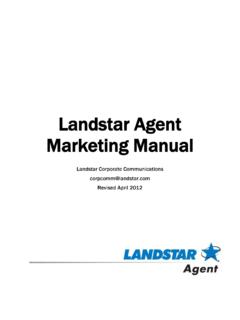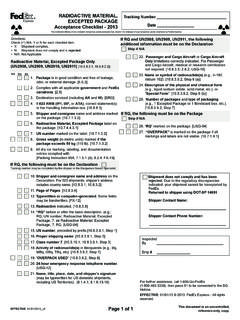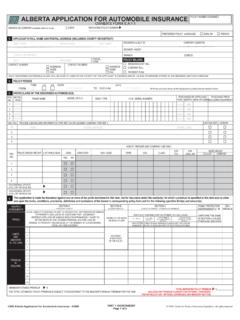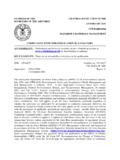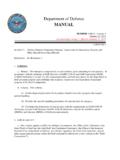Transcription of Hazardous Materials Guidance - …
1 Hazardous Materials Guidance Avoid common violations: PERMITS Refer to Landstar Online for a permit reference guide by state and printable permits o Replace expired permits to avoid unnecessary violations and CSA points. SECUREMENT One securement violation is 21 to 36 points on CSA. o Supervise the loading process whenever possible to make sure cargo is properly secured ( Hazardous or not). o Blocked low and braced higher up anywhere there are void/empty spaces in the trailer. o Shrink wrap and/or banding are required to secure packages to pallets. o Blocking and bracing of pallets is also required. o Do not use damaged (cut/frayed straps, bent chain links, etc.) securement devices. LOCK TRAILER DOORS Never enter a trailer containing an inhalation hazard o Check the load often in case straps have loosened, freight has shifted, or load bars have dropped. o Regulation (FMCSR) , requires inspection of cargo, cargo securement and must be checked within the first 50 miles, at every change of duty status, after driving for 3 hours or 150 miles.
2 Reexaminations may be flagged on line four of the daily log as proof. FLAT BED/PLATFORM TRAILERS Replace damaged securement devices immediately o Make sure the proper amount of tie downs have been used for the weight and length of the load. o Violations received for insufficient &/or damaged securement devices are 21 to 36 points on CSA. SEALED LOADS Never break a customer s seal without permission OR enter a trailer with an inhalation hazard o On shipper sealed trailers, know that any time you suspect the cargo may have shifted you must ensure cargo is properly secured. o Contact the dispatching agent to get proper permission from the shipper before breaking the seal. LOGS Must be kept current to the last change of duty status o Make sure the logs are true and accurate using supporting documentation such as satellite tracking, Qualcomm, Comdata card use, receipts, check calls, etc. o Keep the previous 7 days in your possession. Additional information is provided on Landstar Online PLACARD DISPLAY Lost and/or damaged placards must be replaced immediately o Inspect placards often while in route to ensure placards and/or placard shields fit snuggly.
3 O Landstar BCOs may receive a free set of plastic placard shields by emailing request to Include the street address and truck number with the request. FIRE EXTINGUISHERS All fire extinguishers must be mounted and secured o They must be fully charged at all times. Hazmat loads require at least a 10 B:C type extinguisher. ERG Current issue is the orange 2012 Emergency Response Guidebook o Must be kept in the same manner as hazmat shipping paper(s) while in transit, within reach, with seatbelt fastened, AND readily visible to an officer or in the driver side door pouch. The hazmat shipping paper(s) should remain on top of all paperwork and books. Know how to locate the appropriate guide(s) in the book. o Do not provide an officer hazmat shipping paper(s) enclosed in the book. CHECK CALLS/STATUS UPDATES MANDATORY for shipments of Class/Division: , , , , , & (Poison Inhalation Hazards Zone A & B). These commodities require trucks with Qualcomm. o Macro 12 completed at departure from shipper, Macro 13 at change of duty status (every driver change and on/off duty) and Macro 14 delivery status update once unloading is complete o See online Marco training at o Don t forget Macro 40 for route plan prior to departing shipper CHECK CALLS/STATUS UPDATES For shipments other than listed above o BCO/Truck Operator must make daily check calls and a delivered check call for all loads.
4 O Check calls can be done via internet ( ) and the IVR (interactive voice response) system. If you cannot access the IVR or internet, contact the dispatching agent or the Freight Operations department. COMPLIANCE UPDATES ARE AVAILABLE - Please visit our websites: & Hazmat Shipping Paper/Placard Guidance - On reverse side This checklist will assist in your preparation for compliant Hazardous material shipments. The front portion of the Hazardous Materials Compliance Pocketbook provides valuable information to use as well. Shipping Papers: shipper responsibility to provide ____ 1. Shipper name and address ____ 2. Consignee name and address ____ 3. Identification Number as indicated in the Hazardous material Table in column 4 (example: UN1263 or NA1760). ____ 4. Proper Shipping Name as indicated in the Hazardous material Table in column 2. The letter G in column 1 indicates one or more technical names must be entered in parenthesis ( ) in association with the basic hazmat description.
5 ____ 5. Hazard Class/Division as indicated in the Hazardous material Table in column 3 (include any additional sub hazards in parenthesis ( ) indicated in the Hazardous material Table in Column 6). ____ 6. Packing Group (I, II or III) as indicated in the Hazardous material Table in column 5. ____ 7. Piece count, package type and weight with the unit of measure (lbs, kgs, etc.) are required for each Hazmat entry. ____ 8. Hazmat descriptions must be either entered first in the description area, or be entered in a contrasting color (may be highlighted) or be identified by an X placed before the basic shipping description in a column captioned HM. (The X may be replaced by RQ, if appropriate.) ____ 9. Emergency response phone number (24/7) must be indicated & must include the registrant s company name or contract #. ____ 10. Shipper s certification statement must be present on the hazmat shipping paper/bol and legibly signed by the shipper either manually, by typewriter or by other mechanical means.
6 ____ 11. When shipping inhalation hazard Materials , ensure the shipping description indicates Poison Inhalation Hazard- Zone A, B, C or D as appropriate or Toxic Inhalation Hazard Zone A, B, C or D as appropriate when required. Each description of a Hazardous material must be in sequential order of ID Number, Proper Shipping Name, Hazard Class and Packing Group (PG) when PG is required, which reflects the order of 3, 4, 5 and 6 from checklist above. Abbreviations are prohibited except for packaging type, quantity, or limited quantity (LTD QTY). Emergency response guide information must accompany shipment. Keep the Emergency Response Guidebook with shipping papers, within reach with seatbelt fastened & readily visible or in the driver s door pouch. Know what guide number(s) apply to Materials being transported. Placards: Shippers must furnish placards when required. Reference the Placard section of Hazmat Compliance Pocketbook to determine proper placards.
7 They must be in good condition. Request additional placards if possible in case they are lost in route. Ensure they are in place on the vehicle prior to departure. Check them often while in route & immediately replace if lost or damaged. Shipments with bulk packages (tote bins, super sacks, etc.) require placards with the Identification number in the center for each different material in bulk packaging. The Identification number is the 4 digit UN/NA number of the material . Reference the General Requirements section of the Hazmat Compliance Pocketbook to determine proper placards with ID numbers. ID numbers cannot be handwritten on placards! Large quantities of non-bulk packaging A transport vehicle or freight container containing only a single Hazardous material in non-bulk packages must be marked, on each side and each end with the material s identification number, subject to the following: o Each package must be marked with the same proper shipping name and identification number; o The aggregate gross weight of the Hazardous material is 4,000 kg (8,820 lbs) or more; o All of the Hazardous material is loaded at one facility; and o The transport vehicle or freight container contains no other material Hazardous or non- Hazardous .
8 ID number markings must be displayed across the center area of the primary hazard class placard, a white square on point, or an orange panel affixed to a background of contrasting color, clearly visible and away from other markings. The 4 digit ID numbers must be inches tall ( inches tall if on orange panels), black, durable, pre-printed (not handwritten). Labels must represent the hazard class of the product being shipped. Labels must be securely affixed to each package near the proper shipping name, un-obscured and away from any other markings. Multiple labels are required when subsidiary hazards are present including "Toxic by Inhalation/Poisonous Inhalation Hazard" (see Special Provision codes in column 7 of the Hazardous Materials Table). Definitions of the codes are located in the back of the Hazardous Materials Compliance Pocketbook. Almost all non-bulk packaging must also show proper shipping name and the UN or NA identification number. For limited quantities refer to the Exceptions section of the Hazardous Materials Compliance Pocketbook.
9 Mixed loads: Check the Hazardous Materials Load and Segregation Chart. Certain Materials may not be compatible. *Poison & radioactive Materials may not be loaded with food/feed products (including Materials with subsidiary hazards).

